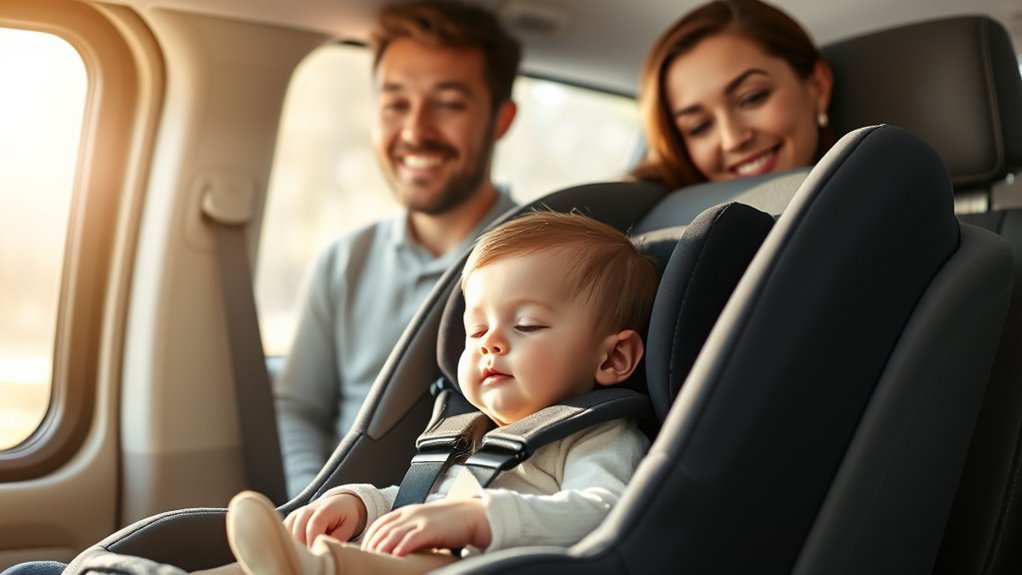As a parent, understanding car seat sleep safety is crucial for your child’s well-being. Car seats are designed for travel, not for extended sleep, and improper positioning can lead to serious risks like restricted airflow. It’s essential to recognize the signs of discomfort and know safer alternatives for naptime. Let’s explore how you can keep your child secure and comfortable during travel without compromising their safety on the road.
Understanding the Risks of Sleeping in Car Seats
While it might seem convenient to let your child sleep in their car seat during a long drive, you should be aware of the potential dangers involved.
Car seats are designed for safety during travel, not for sleep. When your child dozes off, their head can slump forward, restricting airflow and increasing the risk of suffocation.
Additionally, the angle of a car seat may not provide the necessary support for prolonged sleep, leading to discomfort or even respiratory issues.
In case of an accident, a sleeping child in a car seat could face greater risks due to improper positioning.
To guarantee your child’s safety and well-being, always prioritize appropriate sleeping arrangements outside of the car. Your vigilance can make a significant difference.
Proper Car Seat Positioning for Sleep
To guarantee your child’s safety while they sleep in a car seat, proper positioning is essential. Here are three key steps to make certain your little one is secure and comfortable:
- Angle the seat correctly: Make sure the car seat is reclined at the appropriate angle. This prevents your child’s head from slumping forward, which can obstruct their airway.
- Secure harness straps: Adjust the harness straps to fit snugly against your child’s body, making sure they’re not too tight or too loose. A secure fit keeps them safe during a sudden stop.
- Check the seat location: Place the car seat in the back seat, ideally in the center position, to maximize protection in case of a collision.
Signs Your Child Is Uncomfortable or Unsafe
How can you tell if your child is uncomfortable or unsafe in their car seat? Recognizing the signs is essential for their safety. Watch for these indicators:
| Signs | What It Means | Action to Take |
|---|---|---|
| Fidgeting or squirming | They’re not properly secured | Adjust straps and position |
| Crying or fussiness | They might be uncomfortable | Stop to check and soothe |
| Leaning forward | Unsafe posture | Confirm the seat is reclined |
If you notice any of these signs, address the situation immediately. A child’s discomfort can lead to unsafe conditions, so stay vigilant and prioritize their well-being while traveling.
Guidelines for Safe Travel and Naptime
Guaranteeing your child’s safety during travel and naptime requires following specific guidelines to create a secure environment.
By adhering to these practices, you can provide peace of mind both on the road and during rest:
- Always use a car seat that fits your child’s age and weight, guaranteeing it’s properly installed.
- Limit naptime in the car to short durations. Excessive sleep in a car seat can lead to discomfort and safety risks.
- Monitor your child’s position regularly. Guarantee their head isn’t slumped forward, which can obstruct breathing.
Alternatives to Car Seat Sleeping for Long Trips
While car seats are essential for safety, there are several alternatives for helping your child rest comfortably during long trips.
Consider investing in a travel crib or portable bed that provides a safe sleeping environment. These options allow your child to lie flat, reducing the risk of airway obstruction.
If you’re stopping frequently, use a playpen so your little one can stretch out and nap comfortably.
You could also try a hammock-style seat designed for rest during travel, ensuring it meets safety standards.
Always prioritize safety first, but remember that your child deserves a restful journey.
Just make sure to follow guidelines regarding safe sleep practices, whether at home or on the road.
Frequently Asked Questions
Can My Baby Sleep in a Car Seat During Short Trips?
Yes, your baby can sleep in a car seat during short trips, but make certain they’re secured properly. Monitor their position to prevent slouching, which can hinder breathing. Always prioritize their safety and comfort while traveling.
What Age Is Safe for Sleeping in a Car Seat?
It’s generally safe for infants under one year to sleep in a car seat during short trips. However, after that age, prioritize transferring them to a flat, safe sleeping surface for healthier sleep habits.
How Often Should I Check on My Sleeping Child in the Car?
You should check on your sleeping child every 20 to 30 minutes, like a lighthouse guiding a ship. Regular checks guarantee their safety and comfort, letting you embrace the journey with peace of mind.
Are There Specific Car Seat Brands Safer for Sleeping?
Yes, some brands prioritize safety features for sleeping children, like Britax and Graco. Look for car seats with high safety ratings, proper recline angles, and side-impact protection to guarantee your child’s comfort and security while resting.
What Should I Do if My Child Falls Asleep in the Car Seat?
If your child drifts into dreamland in the car seat, gently wake them and transfer them to a safe sleeping space. Just like a ship needs a steady dock, every child deserves a secure bed to rest.
Conclusion
In the journey of parenting, your child’s safety is the compass guiding every decision. While car seats are your trusty vehicle for travel, they’re not a cradle for sleep. Always prioritize safer alternatives for naptime, ensuring your little one rests like a flower in sunlight, free from the shadows of risk. By staying vigilant and informed, you’re not just protecting your child; you’re nurturing their growth and well-being on every ride. Safe travels!
